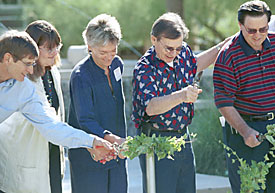 |
|
DANIEL BERDANER/Arizona Daily Wildcat
|
David Yetman, Nancy Morin, Campus Arboretum Director Libby Davison, President Peter Likins and Warren Jones celebrate the university's acceptance into the American Association of Botanical Gardens and Arboreta by cutting a vine outside Old Main on Saturday. Some of the oldest trees in Arizona are now recognized as part of the Campus Arboretum, a collection of over 500 plants.
|
|
By Jose Ceja
Arizona Daily Wildcat
Monday September 30, 2002
The UA Campus Arboretum gained national recognition Saturday in a ceremony featuring three boojum trees that were at the center of a development controversy on the UA campus earlier this year.
Over 300 people attended the celebration, which marked the UA's acceptance into the American Association of Botanical Gardens and Arboreta.
President Peter Likins opened the event, which featured a speech by David Yetman, UA alumnus and host of KUAT's "The Desert Speaks."
Yetman commented on some of the diverse trees on campus, like the floss silk tree, located north of Old Main, recognizable by its orchid-like flowers and spikes protecting its trunk and limbs.
He also defended the flora of the desert.
"Everyone is talking about the greenery around here," he said. "I just returned from British Colombia, where it is really green, but I tell you, brown is beautiful."
Nancy Morin, a professor at NAU and the executive director of the botanical association, presented the UA with a plaque commemorating the arboretum's induction into the organization.
The event concluded with a vine ÷ as opposed to a ribbon ÷ cutting ceremony to celebrate the induction of the Campus Arboretum.
"I've cut a lot of ribbons in my life, but I've never cut a vine before," Likins said. "Sometimes we have the opportunity to come together to celebrate our historical role in society. Here I have a special opportunity to celebrate the beauty of this campus with you all."
Over 40 people toured the Campus Arboretum, a campus-wide collection of over 500 plants representing over 100 years of botanical history that Libby Davison said has been enriched by generations of UA members.
The arboretum's roots date back to 1895 with the planting of olive trees along what is now North Campus Drive. Since then, Davison said, the UA campus' botanical collection has been expanded in a number of ways.
As a forerunner in cataloging the flora of the Sonoran Desert, many UA professors have brought native species onto the UA campus.
But the Campus Arboretum has also been enriched by plants from arid regions as far as Saudi Arabia and South Africa. Many of these plants were introduced to the UA campus to test their adaptability to urban environments, Davison said.
"Many of these plants were grown for the first time in Arizona there (the arboretum)," she said.
To support the Campus Arboretum, 90 boojum seedlings, were sold for $20 each.
Davison credits the tall, thin tree, which is native to Baja, Mexico, for drawing attention to protest the Campus Arboretum. Last year, hundreds of people came forward to the proposed moves of the trees from the Joseph Wood Krutch garden to make room for the Alumni Plaza.
Instead, the Krutch garden will be incorporated into a new plaza design unveiled by Likins last spring.
In an effort to raise money for the plaza and the arboretum, naming rights of four "Heritage trees" will be auctioned for $25,000 and a number of other naming rights will be sold for $5,000. Some of the "Heritage trees" offered include an African Fever Tree, an Indian Golden Shower Tree and a Central American Calabash Tree.
Davison said money raised will go to maintain the arboretum, purchase new plants, move plants around campus and organize a volunteer program.
To learn more about the arboretum, visit http://www.ag.arizona.edu/arboretum/plantwalks.html.

